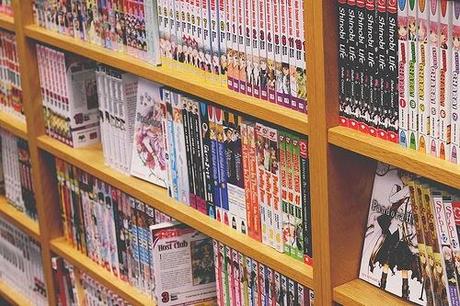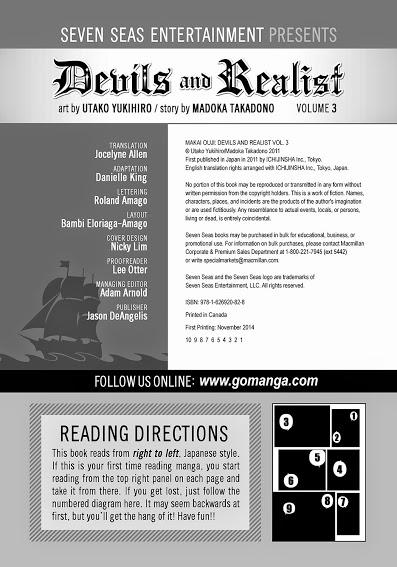
So not surprisingly, after I did my post where I discovered a trend where most manga publishers have started to stop including right to left diagrams in their manga volumes, I was curious about it. So I asked people working in the industry why this is the case, and if this is something we’re going to have to embrace: all manga no longer having the diagrams included.
I guess it makes sense that I got answers that were practically all the same, to an extent.
The common theme that I got from everyone is that the reason the diagram is included is due to page count. It depends on the manga obviously, but instead of having blank pages (like I’ve noticed some novels seem to have), they generally do 3 things:
- Add the diagram
- Add ads of other manga in their catalog
- Add a picture
This doesn’t count any translation notes, preview of the next volume, or information of who was behind the production of the volume, since one or two or all of those are always included. But as I said, the diagram for some manga publishers is not included. Is this something most publishers prefer?
“Honestly, I would rather not at all times.” But, as Ed Chavez (Vertical’s Marketing Director) told me, it’s either that or getting an ad design approved for the book. It’s easier to have a right to left diagram.
Abigail Blackman, an associate editor at Yen Press — and one of the few publishers who rarely had a manga diagram included in their manga — let me know that her impression of having the diagram included was, “unnecessary and perhaps a little insulting to the reader.”
“The message of the chart is: The book reads in reverse,” she continued. “That’s really all the reader needs to know, and the fact that the cover/title start on the right should be enough to communicate that.” Even with the diagram, she added, if you’re reading manga for the first time you still have to read it and get the nuances of right to left and panel reading regardless. But she does think, aside from the first time and maybe a few volumes after that, that it’s a bit silly to still have that in the back of a manga series in its 20th volume.
It’s a bit similar with Kodansha. As I noted, Kodansha’s volumes had the stop page included in their volumes, but sometime in 2013 they stopped including that. Ben Applegate (manga editor), while again acknowledging it’s just a page space issue, also understands that if it’s past Vol 8 of a manga or if it’s a spinoff manga, there’s no need for the diagram.
“I think putting a notice at the end is just a little silly.” Robert McGuire, Editor-in-Chief of Gen Manga, told me. Gen Manga does not have a last page diagram. It makes sense since their market is for those who already know manga, especially since they publish indie manga. They do, however, have a small guide at the start of their manga. “I think that’s all publishers really needed to do in the first place. But, even that is becoming increasingly unnecessary.”
That may ultimately be the way publishers, or some of them, could go. Seven Seas, for example, used to have the right to left diagram (as you saw with Kashimashi), but in 2011, they stopped including it and started using the extra page to advertise current and upcoming titles in their company. But Seven Seas managing editor Adam Arnold let me know they thought a simple direction would be helpful:

“We felt that keeping some kind of right to left reading direction in the books was necessary for new readers,” he said, “so we redesigned our copyright pages in such a way that the upper portion of the page was devoted to staff credits/title copyright information, and the bottom portion reserved for reading directions.” You’ll still see advertisements included in most of their catalog.
Out of all the current publishers that include the diagram or stop sign at the end of the products, only Viz, depending on what line they’re catering to, and Digital Manga Publishing have it in all of their works. I was not able to get a response from Viz, but I did get one from Yoko Tanigaki, VP Sales and Distribution at DMP. “[We include the diagram] because there are always new readers who are unfamiliar with the right to left reading format.” And it looks like that may not stop, but who knows what can change a year or two from now?
Anyways, it’s clear that there’s a reason for why publishers include or don’t include a diagram. Does it even matter? “I don’t think it makes much of a difference one way or the other though,” Ben mentioned as I asked whether or not it actually helps/hurts releases. Not surprisingly this was the sentiment I got from everyone else: it’s not always necessary, but at least we can do something with that extra page and not just leave it blank.
“Personally, I don’t see a real downside to our approach,” as Conner Crooks, social media manager at Seven Seas, explained to me about their last page and how it looks. Though he does know that because of what Seven Seas actually publishes, he expects there’s no reason to have an entire page dedicated to informing them they’re accessing the book incorrectly, so might as well use it for something else. Instead, just having the copyright information and small diagram should work out well enough.
Overall though, I’m getting the sentiment that we’ll be embracing a scene where publishers say, “Hey, readers know what manga is, let’s utilize the last page in a smarter way that can be beneficial to us. Maybe new readers still do need to have that last page to guide them, or they’ll just have to understand you’re reading a book or graphic novel, but in reverse. Abigail summarizes it best:
“I suppose in the end, I personally don’t think too many regular readers of manga reference the ‘You’re reading the wrong way!’ page. And chart or not, new readers aren’t going to get the hang of it until they dive into the actual comic, after which they too will probably never spare more than a glance for the page again.”
The following two tabs change content below.- Bio
- Latest Posts

Justin
Justin is the founder of Organization Anti-Social Geniuses. Anime & manga fan that likes to blog about anime and manga, is addicted to sports, and weak to crossovers. You can follow Justin on Twitter @Kami_nomi.
Latest posts by Justin (see all)
- Manga Publishers On Last Pages in Manga Volumes - August 21, 2014
- Reference Resource Mondays: Time Vs Anime - August 18, 2014
- Notes of Great Teacher Onizuka 2014 Episode 6 - August 15, 2014
- I Put My Money Where My Mouth Is And Bought Accel World: Kuroyukihime’s Return - August 14, 2014
- Seraph of The End Vol 1 Review - August 13, 2014

